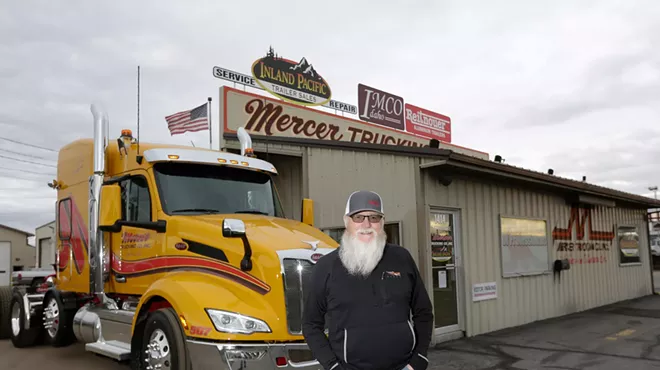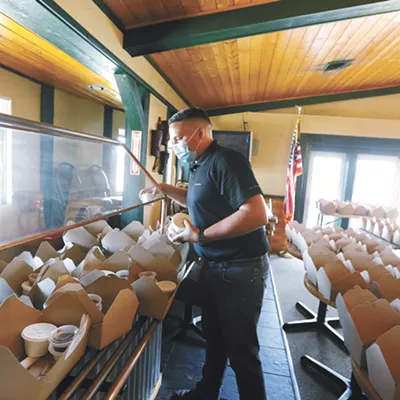Earlier this year, the Washington State Employment Security Department doubled down on efforts to find U.S. farmworkers and spent thousands of dollars on posters, flyers, radio ads and recruitment at job fairs.
The end result: one referral and zero hires.
Dan Fazio, executive director of Washington Farm Labor Association, says he doesn't blame the Employment Security Department for not finding any workers; he faults them for not telling people it was a fool's errand.
"It's basically impossible to find U.S. workers," Fazio tells the Inlander.
The shortage of local farmworkers in Washington predates the pandemic by almost three decades, Fazio says. Farm work — especially the labor-intensive type needed to harvest berry and fruit crops in the Columbia Basin — is physically demanding. The hours are long, and the wages aren't great. Young people are leaving small towns for cities with better-paying jobs in restaurants, construction and warehouses. Agricultural work is seasonal, which can dissuade people looking for stability.
None of this is new, which is why some growers and farm owners in Washington have increasingly turned to labor from other countries. The H-2A program lets farmers who can't find domestic workers bring in foreign workers on temporary work visas. A majority of H-2A farmworkers come to Washington from Mexico and other countries in Latin America.
There's no shortage when it comes to H-2A workers. The number of foreign workers applying to the H-2A program is generally higher than the number of workers requested by farmers, Fazio says. About 25,000 farmworkers came to Washington on H-2A visas in 2020, and the number is on track to be even higher in 2021.
But despite the availability of H-2A workers, Fazio says farm owners will frequently tell him they can't use the program. There are three main complaints. The first, Fazio says, is that farmers are worried about being subjected to regulatory and political scrutiny. The second is housing. Farm owners who use the H-2A program are required to provide housing for the migrant farmworkers they employ, in addition to transportation and other amenities.
The third reason is wages. The H-2A program requires farmers to pay workers an hourly wage based on estimates for the average hourly wage in the area. A November report from the Department of Agriculture puts the hourly wage for next year at $17.41.
"If you use the legal worker program, you have to pay a higher wage than if you hire undocumented workers," Fazio says. "Kind of nonsensical, but it is what it is."
The Department of Labor estimates that about 50 percent of the U.S agricultural workforce is undocumented. Elizabeth Strater, director of strategic communications for the United Farm Workers, pushes back on the argument that the high costs of the H-2A program encourage farmers to hire undocumented workers. Many growers are already doing that, she says, and are more than willing to look the other way.
The guardrails built into the H-2A program are necessary because migrant workers are especially vulnerable to exploitation and wage theft, Strater says. She notes that the costs associated with the H-2A program pale in comparison to the physical toll farm work takes on migrant workers.
"These are folks that do not have easy choices when it comes to providing the bare minimum for their families, and that is really easily exploited," Strater says.
Strater says that lack of choice is why so many migrant farmworkers have continued to work throughout the pandemic, floods, wildfires and other hazards of the past two years.
Fazio says the financial strain — which was made worse during the pandemic because of supply chain issues — is leading some smaller farmers to sell to larger corporate farms, or switching to grain crops that are less labor-intensive.
Jeff Emtman is one of the owners of Emtman Brothers Farms just outside Spokane. He says the lack of local farmworkers isn't as severe in the eastern part of the state where less labor-intensive grain crops are more common.
Emtman's farm has been doing all right when it comes to finding seasonal workers, and he hasn't had to rely on the H-2A program. During the peak of the harvest season, Emtman typically employs about 16 farmworkers, sometimes from local high schools.
"The equipment is pretty efficient, so we're able to get by with a limited amount of labor producing the crop," Emtman says.
But Emtman is struggling with a different type of labor shortage. His farm typically employs around six truckers to help transport crops to buyers during harvest season, but he says finding truckers has been especially difficult this year.
The trouble finding truckers is especially challenging for Emtman's hay crops, which need to be moved quickly after being harvested. Emtman said it's a source of concern and that he has talked about potentially scaling down the hay harvest in favor of grain crops, which don't need to be transported immediately after harvest.
In the long term, Fazio worries that the rising cost of the H-2A program will lead more farmers to pull out of the business entirely, driving inflation and outsourcing food production to other countries.
Strater doesn't buy it. She says the hardships faced by migrant farmworkers far outweigh the cost of proper compensation.
"This is not an economic question that we're necessarily asking," Strater says. "This is a moral question." ♦






























